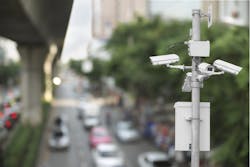Most people today who live in cities, particularly large ones, have become accustomed to a relatively high level of general and public surveillance, whether it is the police patrolling the streets, cameras in shopping malls or intelligent security solutions deployed in public transportation systems.
Physical security systems are capable of delivering safety to citizens, though the management and operation of these systems can be challenging at times. Cities often use video management systems or other platforms to view camera footage, protect citizens and property, analyze incidents, evaluate security and to help them determine appropriate responses to events such as natural disasters, disruptions to transportation and other municipal services, and other public safety threats. They may also use intrusion, access control, building automation and fire detection systems in their management of a city’s security, in conjunction with video surveillance.
Cities implementing this connected security approach have been dubbed “safe cities” — and most of them share a common infrastructure and operate using sensors and/or cameras over a shared municipal network. Using these sensors and the data from many different devices synthesized through one interface, government officials and law enforcement are afforded a total, holistic view of a city’s security.
Integrating the Many Parts of a Safe City
The integration of all of these systems is obviously a key aspect, and one that greatly affects the systems integrators, who are often tasked with giving a municipality the ability to manage its security comprehensively and from a single point of view from a command center.
Integrators are often faced with operational challenges that accompany the many systems that are included in a safe city deployment; and interoperability continues to present one of the greatest challenges — particularly with VMS, video recording and cameras. Municipalities commonly have several different management systems for operations that were created by different manufacturers, each with proprietary interfaces for integration.
In order to connect the different systems, cities often end up employing a build once and maintain forever approach, in which the continuing cost for integration of the city’s systems becomes prohibitively expensive. This scenario is not practical or attractive, as it severely limits the end-user’s ability to deploy new technology.
Some end-users and integrators approach this problem by deploying products from a single manufacturer in order to facilitate system-wide integration; however, this approach can stifle the ability to add new products from other vendors and locks the project into a long-term commitment with a manufacturer.
Standards Create Interoperability
The scenario above is where the need for robust and well-defined standards comes into play — particularly for video surveillance, which is generally at the heart of safe city deployments. Standards, such as those from ONVIF, can provide the common link between disparate components of these systems. Designed specifically to overcome the challenges in multi-vendor environments, ONVIF’s common interface facilitates communication between technologies from different manufacturers and fosters an interoperable system environment where system components can be used interchangeably, as long as the devices conform to the ONVIF specification.
ONVIF has published a number of specifications and profiles for effective integration of devices for physical security. For video, they include Profile S for video streaming and Profile G for storage and playback, and Profile Q for easier installation and deployment.
In a safe city scenario, much of the recorded video from video security systems is used to conduct post-event forensic investigations, which often requires coordination with local, county, state and sometimes federal law enforcement. The challenge in a multi-vendor environment is that authorities often receive exported video material in a host of formats with a multitude of playback methods.
Here, a standardized approach for both file format and associated players — which ONVIF’s specification provides — increases the efficiency of the process and also adds the potential of including metadata in exported materials and reports, which determines the exact time and location of the recorded incident. ONVIF’s export file format specification outlines a defined format for effective export of recorded material and forensics.
Other standards organizations outside the physical security industry have identified the need for standards in effective Safe City deployments, such as the International Electrotechnical Commission (IEC) and Institute of Electrical and Electronics Engineers (IEEE). IEC has initiated a Systems Evaluation Group for Smart Cities that will evaluate relevant works and propose a standardization roadmap — a term often used synonymously with safe cities. The group will also provide a mapping of closely related activities in cooperation with the International Organization for Standardization (ISO) and other organizations going forward.
In 2013, the IEC included an ONVIF specification in its IEC 62676 standard for video surveillance systems, the first international standard to be established. Earlier this year, IEC included ONVIF’s specification for electronic access control — which includes minimum functionality, performance and testing methods for electronic access control systems and components — in the IEC 60839-11 standard for alarm and electronic security systems.
ONVIF Members’ Safe City Solutions
Two ONVIF members — Meyertech and Huawei — have used ONVIF prominently in safe city deployments in large cities.
In 2014, Meyertech helped the city of York, U.K., to deploy a safe city solution for the city’s public spaces and transportation system. Using Meyertech VMS and information management software, the city was able to integrate IP cameras with the many legacy systems in a central command center. The city’s integration of more than 150 legacy and new IP cameras with the new VMS, which interfaced with the information management software, was possible by using ONVIF video specifications.
Huawei has deployed smart city solutions in Nairobi, Kenya, and in China in the cities of Nanjing and Shanghai. Huawei’s VMS was used in the Shanghai project as part of the Chinese Ministry of Public Security’s safe cities construction initiative. One of the key challenges of the project was to integrate old and new technology, where interoperability specifications helped integrate cameras from Dahua, Haikang, Axis, Sony and other manufacturers.
Multi-Discipline Physical Security Standard
ONVIF’s vision is that all physical security systems will eventually have the same interfaces for interoperability, and is working to develop a multi-discipline standard. Such an all-encompassing interface would provide a comprehensive approach to interoperability that would satisfy the core elements of video surveillance, access control and other essential operations of a safe city command center.
Because safe city deployments and the Internet of Things concept operate on the same principles of connecting disparate systems and devices together, a multi-discipline physical security standard would no doubt also play a role in the further development of the IoT.
The IEEE (the Institute of Electrical and Electronics Engineers) is already working on IoT standards for technology-based industries, and if an IoT standard is developed, it will likely have an influence on safe city deployments.
As standards and industries collaborate to establish minimum interoperability standards, the need for a multi-discipline physical security standard may present itself, rather than creating proprietary multi-discipline systems. We are not at that point yet as an industry, but the standard is certainly somewhere on the proverbial horizon.
Per Björkdahl is Chairman of the Steering Committee of ONVIF. For more information, visit www.onvif.org.







